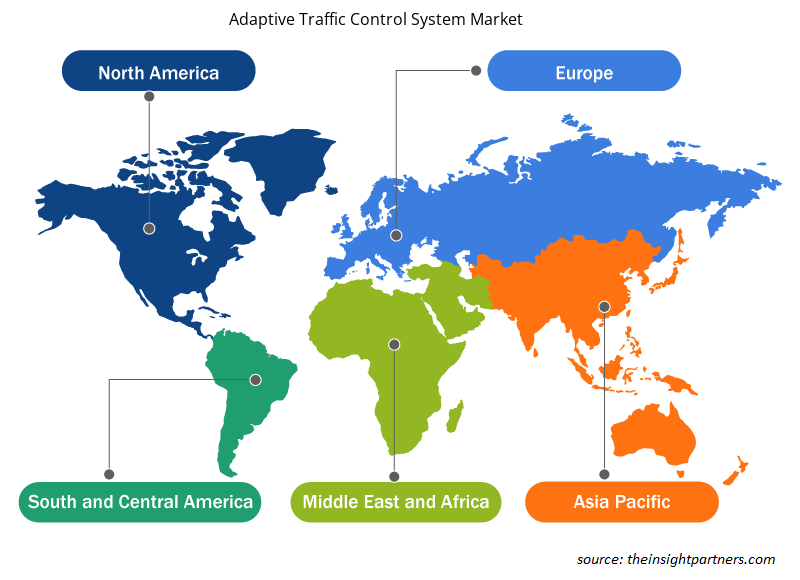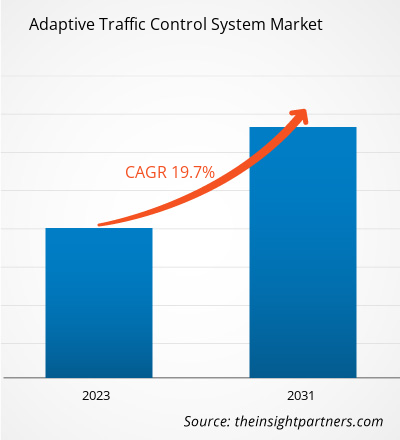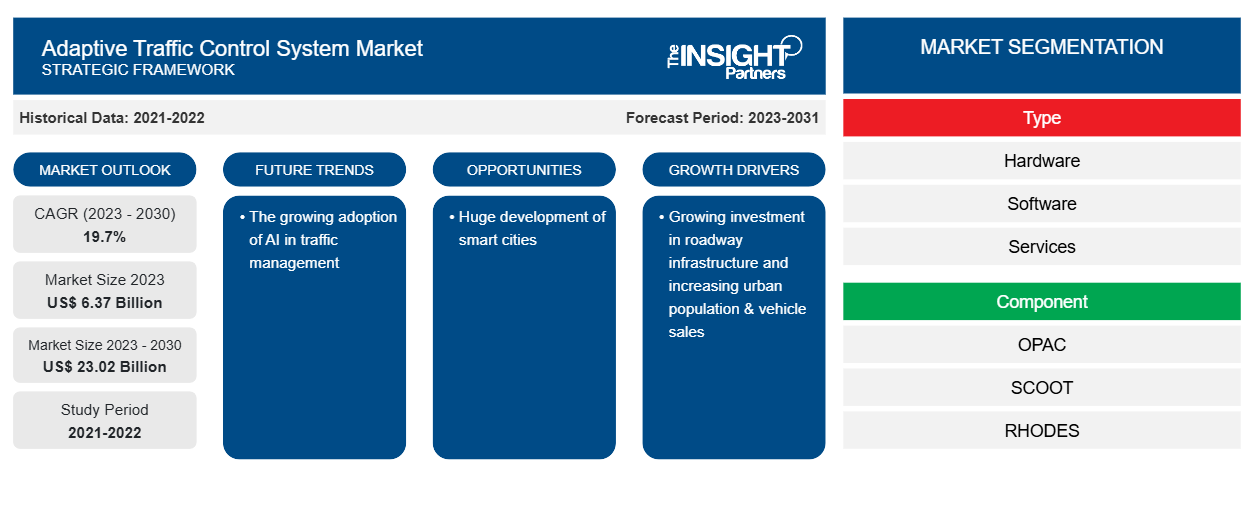適応型交通管制システムの市場規模は、2023年の63億7,000万米ドルから2030年には230億2,000万米ドルに達すると予測されています。市場は2023年から2030年の間に19.7%のCAGRを記録すると予想されています。交通管理におけるAIの採用の増加は、市場の主要なトレンドであり続けると思われます。
適応型交通管制システム市場分析
過去数年間、適応型交通管制システム市場は、道路インフラへの投資の増加、都市人口と自動車販売の増加などの要因により、大幅な成長を遂げてきました。スマートシティの大規模な開発は、適応型交通管制システム市場に有利な成長機会を提供します。
適応型交通管制システム市場の概要
適応型交通管制システム (ATCS) は、都市が複雑な道路網とともに交通信号や歩行者信号を管理し、交通の流れを最適化できるようにするソリューションです。適応型交通管制システムは、リアルタイムの交通パターンに適応し、青信号のタイミングを動的に変更することで交通の流れを最適化します。各交差点の交通量と近くの交差点からの予想到着数に基づいて、ATCS アルゴリズムは交通信号のタイミングを継続的に変更します。車が徐々に青信号を通過できるようにすることで、移動時間が大幅に短縮され、スムーズな流れが促進されて交通が緩和されます。
要件に合わせてレポートをカスタマイズする
このレポートの一部、国レベルの分析、Excelデータパックなど、あらゆるレポートを無料でカスタマイズできます。また、スタートアップや大学向けのお得なオファーや割引もご利用いただけます。
-
このレポートの主要な市場動向を入手してください。この無料サンプルには、市場動向から見積もりや予測に至るまでのデータ分析が含まれます。
適応型交通管制システム市場の推進要因と機会
道路インフラへの投資拡大が市場を有利に導く
人口増加により、より良い道路状況、スムーズな交通の流れ、異なる地域間の接続性など、より良い交通施設への需要が世界中で高まっています。その結果、さまざまな国の政府当局は道路インフラの開発に注力しています。 2022年6月、中国政府は120の新しい高速道路と一般的な国と省の高速道路プロジェクトを開始する計画を発表しました。その範囲は3,600キロメートルを超えます。総額272億ドル(1,820億元)がこれらのプロジェクトに割り当てられます。同様に、2022年3月、VINCI Highwaysはドイツのミュールハウゼンとバートランゲンザルツァ間のB247道路の拡張が開始されたと発表しました。この道路の建設のために、政府は約5億4,561万ドル(5億ユーロ)の投資を承認しました。また、オンタリオ州政府は、2022年4月から2023年3月までに州の高速道路と橋の補修と拡張に約30億米ドルを投資すると発表しました。高速道路と橋の補修と拡張には、オンタリオ州南部で約17億米ドル、オンタリオ州北部で約6億2,400万米ドルが使用されました。道路インフラへの投資の増加により、交通の流れを改善し、車両の安全性を高めるために、自動交通管制システムを実装する必要性が高まっています。したがって、乗客とドライバーの安全のためのインフラへの支出の増加は、適応型交通管制システム市場の成長を後押しします。
交通管理における AI の導入拡大
道路交通管理は、人工知能(AI)の急速な発展により、劇的な変化を遂げてきました。現在、人工知能(AI)は、交通ネットワークのさまざまな場所での人、物、車、貨物の動きを正確に予測し、管理することができます。AIは、以前よりも優れたサービスを市民に提供するだけでなく、工事などにより道路が閉鎖されているときに安全な移動を可能にし、交差点の交通パターンを最適化することで事故の数を減らします。さらに、膨大な量のデータを処理し、評価するAIの能力により、公共交通機関のようなライドシェアリングサービスが有効になりました。
適応型交通管制システム市場レポートのセグメンテーション分析
適応型交通管制システム市場分析の導出に貢献した主要なセグメントは、タイプ、コンポーネント、およびアプリケーションです。
- 適応型交通管制システム市場は、種類によってハードウェア、ソフトウェア、サービスに分かれています。ハードウェアセグメントは、2022年に大きな市場シェアを占めるでしょう。
- コンポーネント別に見ると、市場はOPAC、SCOOT、RHODES、SCATSに分類されます。2022年にはSCATSセグメントが最大の市場シェアを占めました。
- 用途別に見ると、市場は高速道路と都市に分かれており、2022年には都市セグメントが最大の市場シェアを占めました。
適応型交通管制システム市場シェアの地域別分析
適応型交通管制システム市場レポートの地理的範囲は、主に北米、アジア太平洋、ヨーロッパ、中東およびアフリカ、南米および中米の 5 つの地域に分かれています。
適応型交通管制システムは、英国、アジア、オーストラリアで広く使用されています。米国の信号付き交差点のわずか 1% 未満に、適応型信号制御技術が導入されています。ハードウェアの潜在的な費用に加えて、システムの構成と保守に必要な知識、アクティブなパフォーマンス測定の欠如、適応型信号制御技術の利点に関する誤解などの他の障害により、さまざまな国で適応型交通管制システムの採用が制限される可能性があります。
適応型交通管制システム市場の地域別洞察
予測期間を通じて適応型交通管制システム市場に影響を与える地域的な傾向と要因は、Insight Partners のアナリストによって徹底的に説明されています。このセクションでは、北米、ヨーロッパ、アジア太平洋、中東およびアフリカ、南米および中米にわたる適応型交通管制システム市場のセグメントと地理についても説明します。

- 適応型交通管制システム市場の地域別データを入手
適応型交通管制システム市場レポートの範囲
| レポート属性 | 詳細 |
|---|---|
| 2023年の市場規模 | 63億7千万米ドル |
| 2030年までの市場規模 | 230.2億米ドル |
| 世界のCAGR(2023年~2030年) | 19.7% |
| 履歴データ | 2021-2022 |
| 予測期間 | 2023-2031 |
| 対象セグメント |
タイプ別
|
| 対象地域と国 |
北米
|
| 市場リーダーと主要企業プロフィール |
|
適応型交通管制システム市場のプレーヤー密度:ビジネスダイナミクスへの影響を理解する
適応型交通管制システム市場は、消費者の嗜好の変化、技術の進歩、製品の利点に対する認識の高まりなどの要因により、エンドユーザーの需要が高まり、急速に成長しています。需要が高まるにつれて、企業は提供を拡大し、消費者のニーズを満たすために革新し、新たなトレンドを活用し、市場の成長をさらに促進しています。
市場プレーヤー密度とは、特定の市場または業界内で活動している企業または会社の分布を指します。これは、特定の市場スペースに、その市場規模または総市場価値に対してどれだけの競合相手 (市場プレーヤー) が存在するかを示します。
適応型交通管制システム市場で事業を展開している主要企業は次のとおりです。
- アルドリッジ トラフィック コントローラーズ Pty Ltd
- デジコンSA
- EFKON インド株式会社
- エフトロニクスシステムズ株式会社
- カプシュ・トラフィックコムAG
- トラフィクソルITSテクノロジーズ株式会社
免責事項:上記の企業は、特定の順序でランク付けされていません。

- 適応型交通管制システム市場のトップキープレーヤーの概要を入手
適応型交通管制システム市場のニュースと最近の動向
適応型交通管制システム市場は、主要な企業出版物、協会データ、データベースなどの一次調査と二次調査後の定性的および定量的データを収集することによって評価されます。適応型交通管制システム市場におけるいくつかの開発を以下に挙げます。
- Yunex Traffic は、米国市場向けに Yutraffic Blade Advanced Traffic Controller Platform の発売を発表しました。この次世代エッジ コンピューティング コントローラーはデュアル コア プロセッサを搭載しており、今日のあらゆる交通管制アプリケーションに対応できるほど強力で、将来のアプリケーションにも対応できます。(出典: Yunex Traffic、プレス リリース、2023 年 4 月)
- 都市陸上交通局(DULT)は、ウルスール近郊のケンジントン・ロードとマーフィー・ロードの交差点で新しい交通信号システムの試験運用を開始しました。このシステムには、日本のMODERATO(交通最適化のための起終点関連適応管理)技術が組み込まれています。(出典:THE HINDU BUREAU、プレスリリース、2024年2月)
適応型交通管制システム市場レポートの対象範囲と成果物
「適応型交通管制システム市場規模と予測(2020~2030年)」レポートでは、以下の分野をカバーする市場の詳細な分析を提供しています。
- 適応型交通管制システムの市場規模と予測(対象範囲に含まれるすべての主要市場セグメントについて、世界、地域、国レベルで)
- 適応型交通管制システムの市場動向、およびドライバー、制約、主要な機会などの市場動向
- 詳細なPEST/ポーターの5つの力とSWOT分析
- 主要な市場動向、世界および地域の枠組み、主要プレーヤー、規制、最近の市場動向を網羅した適応型交通管制システム市場分析
- 適応型交通管制システム市場の市場集中、ヒートマップ分析、主要プレーヤー、最近の動向を網羅した業界展望と競争分析
- 詳細な企業プロフィール
- 過去2年間の分析、基準年、CAGRによる予測(7年間)
- PEST分析とSWOT分析
- 市場規模価値/数量 - 世界、地域、国
- 業界と競争環境
- Excel データセット
最新レポート
お客様の声
購入理由
- 情報に基づいた意思決定
- 市場動向の理解
- 競合分析
- 顧客インサイト
- 市場予測
- リスク軽減
- 戦略計画
- 投資の正当性
- 新興市場の特定
- マーケティング戦略の強化
- 業務効率の向上
- 規制動向への対応























 無料サンプルを入手 - 適応型交通管制システム市場
無料サンプルを入手 - 適応型交通管制システム市場